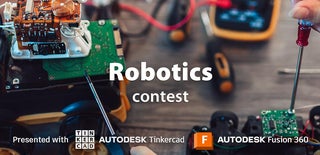Introduction: Solid State Motion System Using Nitinol!
- Work in progress -
Hello fellow makers,
In this Instructable we will be exploring a motion system that does not use any mechanical parts that can wear out and break like motors, servos or solenoids.
There are a couple of projects coming up where I will be using nitinol wire in and this served as an introduction for me into it's capabilities.
Unfortunately due to my location finding nitinol wire is very difficult, the only place that stocked it only had a single 10cm piece available and at a ridiculous price.
So on a search I went to find alternative sources for the mythical memory wire, to my surprise there is a common source for nitinol, there might even be nitinol wire walking around in your house!...BRACES!
Turns out you can easily buy 10 piece packets of NiTi (nitinol) orthodontic wire online and they are super cheap, the only drawback is their working temperature is human body temperature range which isn't a problem for most readers in the northern part of the globe but with the record breaking heatwave we are currently experiencing in South Africa as I'm busy writing this it definitely had some drawbacks and I will need to source some industrial nitinol for future projects.
![]()
If you enjoy my Instructables and would like to support my future projects you can Buy Me A Coffee.
Step 1: What You Will Need:
To make your own Nitinol motion system you will need the following:





- Nitinol wire
Amazon - Nitinol Sample Pack - 7 Varieties 0.5-1 - 2mm, 15-40 - 60-80ºC Transition
- Access to a 3D printer
I use a resin printer to get more accurate parts.
Amazon - Creality Halot-Mage Pro Resin 3D Printer
- 5mm brass tube
Amazon - Brass Tube Tubing - 2mm 3mm 4mm 5mm 6mm 7mm 8mm 10mm OD x 0.5mm
- 4mm brass rod
Amazon - 8 Pieces 4mm Brass Round Rods
- Tiger tail wire
Amazon - 0.45mm Steel Tiger Tail Beading Wire
- Long nose pliers preferably self locking
Amazon - Precision Kelly Forceps Locking Tweezers Clamp
- Butane torch
Amazon -
- Lighter
Amazon -
- Some PLA filament
Amazon -
- Lithium grease
Amazon - CRC 5037 White Lithium Grease
- 2-Part CA glue
Amazon -


Step 2: What Is Nitinol?
Nitinol is a type of shape memory alloy that is composed of nickel and titanium. The name "Nitinol" is derived from the combination of the elements symbols and the place of its discovery, the Naval Ordnance Laboratory (NOL) in the United States.
The unique property of Nitinol is its ability to "remember" its original shape and return to it when subjected to certain stimuli, such as heat.
Here's how the shape memory effect works in Nitinol:
- Martensitic Phase: At lower temperatures, Nitinol exists in a phase called martensite, which has a deformed or "memory" shape.
- Austenitic Phase: When heated above a certain transition temperature, known as the transformation temperature, Nitinol undergoes a phase change to austenite. In this phase, it reverts to its original, undeformed shape.
This ability to switch between two different crystal structures and maintain a memory of its original shape makes Nitinol useful in various applications. Some common applications include:
- Biomedical Devices: Nitinol is used in medical devices such as stents and guidewires, where its shape memory property can be employed for minimally invasive procedures.
- Eyeglass Frames: Some eyeglass frames are made from Nitinol, allowing them to return to their original shape even after being bent or twisted.
- Actuators and Robotics: Nitinol is used in actuators and robotics where a compact, lightweight, and precise shape change is required.
- Aerospace Applications: The unique properties of Nitinol make it useful in certain aerospace applications, such as deployable structures.
The ability to undergo a reversible phase transformation with changes in temperature makes Nitinol a fascinating material with diverse applications in various industries.
Step 3: Designing a Test Platform:
For my test platform I decided on this two digit bionic hand, in hindsight a simple claw would have been a lot easier!
Made in Fusion 360 I decided to leave the back of the hand open for easy tinkering as this is a test platform after all and will need a lot of adjustments.
The articulation of the joints are simply based around standard 1.75mm PLA filament as it is slippery enough to not bind up the joints and super easy to work with. For the motion system there is simply two holes running down both digits one for the pull/closure nitinol wire and the other for the spring/open action.
All parts were printed on a Creality Halot One with rigid resin.
Bioprosthetic Hand (V1.0)
Step 4: Making a Nitinol Spring:
The whole motion system relies on a spring that will pulled apart by an external force and will contract when a current/heat is applied, now this step doesn't look that complicated but it took quite a few tries to get something that actually reassemble a spring.
To form a spring you simply need to wrap a wire around a cylinder right...the problem is with nitinol no matter how tight you bend it it will just spring back to its original shape...with force!
To form it it needs to be moulded around the cylinder and heated, but this also has some complications.
Heat it too much and it loses its amazing properties and as soon as you start heating it the force that it wants to return to its original shape with multiplies, so you need to have a way to keep it clamped onto the cylinder, heat it evenly and be able to quench it in water very quickly.
After a few tries I found the best way was to first drill a 1mm hole into a 5mm brass tube, this will hold onto the start of the nitinol wire and the brass tube will control the heating process.

Next I used a pair of self locking pliers to clamp onto the other end of the nitinol wire, I then tightly wound the wire around the tube to form a tight coil.
Holding the end of the brass tube tightly against the handle of the pliers we need to heat up the coil with a butane torch until the shiny silver wire turns golden (being titanium the wire will go from silver to gold,blue and then purple) as you bring the flame onto the coil you will immediately feel quite a strong force applied to the brass tube as it tries to unwind then as soon as it turns golden the force will stop and your coil would have formed, you will need to immediately quench the coil in water as soon as it changes color.

With it cooled you can now remove your coil and if everything went correctly you can pull it as much as you want and it will always return to its original coil.
Step 5: Refining the Test Platform Joints:
As with any motion system we need joints that slide smoothly and without binding and excessive friction.
As 3D printing always has some imperfections and distortion I used some wetted 400 grit sanding paper to sand each joint until I got smooth motion.
An easy way to spot problematic areas with resin prints is to temporarily assemble your joints (I used a drill bit as the hinge) and move it through its motions this will mark up the problematic areas which will be white and chalky.

Afterwards I used a 2mm drill bit and cleaned up all of the hinging holes, 2mm will give enough room for the filament piece but not big enough to cause binding.
Step 6: Nitinol Spring Negative Connection:
For this iteration of the motion system we will be using electrical current to contract the nitinol spring.
I decided that using a single ground/negative buss bar that the ends of the nitinol springs can clip onto will simplify assembly and the electrical setup.
There are two 4mm holes on the inside of the printed palm that I made to fit a 4mm brass rod in, I simply bent the the rod into an L and cut it down to size.

Onto the brass rod I soldered on some copper wire that was bent into circle to clip the nitinol springs onto.

Step 7: Assembly:
Now onto assembling our test rig.
First we need to assemble the digits, I started by applying some light Lithium grease to each of the joints contact points before sliding them into each other. The hinge is made by simple pushing through a piece of PLA filament and then heat up the end of the filament with a lighter until it starts to soften and push it flat against the resin part, next cut off the excess filament on the opposite side and heat it up and press it flat to create a collar that holds the filament piece in place.

Test your joints to make sure they move freely.

For cabling I use jewlers 0.45mm tiger tail wire which is a twisted stainless wire encased in nylon giving a stretch free slippery cable perfect for robotics. The cable is simply knotted on the finger tip side to avoid it slipping down the hole and on the palm side I tied a loop that can clip onto the nitinol spring.

Attach the nitinol spring to the end of the loop in the tiger tail and then the other end onto the bus bar and test out the motion.
Step 8: Joint Return:
This step is still a work in progress, we need a way to create pull force to pull the digit straight again.
A spring can be used but the force it provides gets larger as it stretches further and I want to minimize that.
Next I used the curve that the orthodontic nitinol wire has to my advantage and inserted that into the digit, this worked really well but I needed a slightly thicker wire to provide more spring plus the stainless steel orthodontic wire would be a better fit for this purpose.
Step 9: What's Next:
- Instead of using current through the nitinol wire to heat it up we can utilize miniature peltier modules as shown above attached to the coils to quickly heat and cool the wire, I will be exploring this method in a future Instructable.
Step 10: Enjoy!
To use this system you simply need to provide current across the nitinol spring (a single AA battery works well) this will cause it to heat up and return to its original shape which will pull the digit closed.
When current is removed the wire will cool back down making it malleable and streatch out from the opposite pulling force and the digits will open back up.
With this method you only need a single mosfet switch on each digit to control it creating a fully solid state motion system
I hope you guys find this Instructable useful and if you have any questions please feel free to leave me a message or comment bellow.
Thank you for taking the time to read through my project and as always..
Happy making!

Runner Up in the
Robotics Contest



















